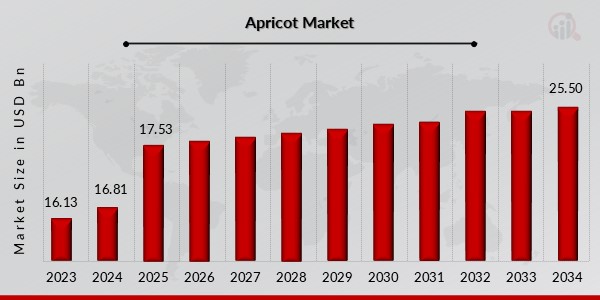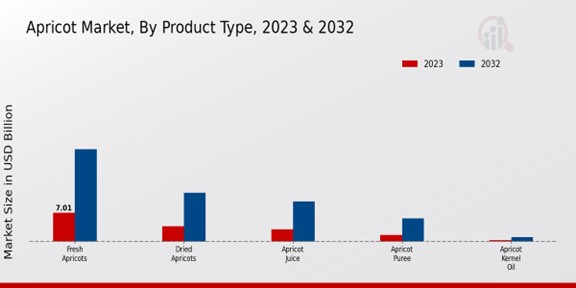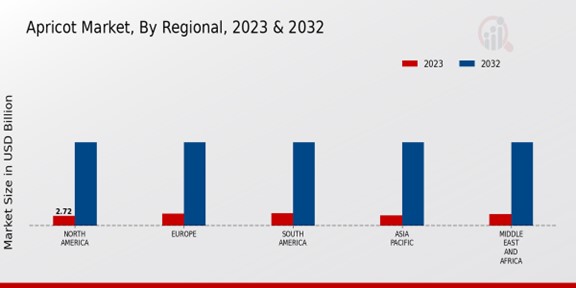Global Apricot Market Overview
Apricot Market Size was estimated at 16.81 (USD Billion) in 2024. The Apricot Industry is expected to grow from 17.53 (USD Billion) in 2025 to 25.50 (USD Billion) by 2034. The Apricot Market CAGR (growth rate) is expected to be around 4.3% during the forecast period (2025-2034).

Source Primary Research, Secondary Research, MRFR Database and Analyst Review
Key Apricot Market Trends Highlighted
The increasing health consciousness among consumers is propelling the demand for apricots, as they are rich in vitamins, minerals, and antioxidants. The growing emphasis on plant-based diets and the rising popularity of superfoods are further contributing to market growth. Moreover, advancements in cultivation techniques and the development of new varieties with improved shelf life and disease resistance are enhancing apricot production and availability.
The rising demand for processed apricot products, such as dried apricots, jams, and juices, is creating opportunities for market players. The convenience and versatility of these products are appealing to consumers, especially in urban areas. Additionally, the expansion of online retailers and the growing adoption of e-commerce platforms are providing wider distribution channels for apricot-based products.
Recent trends in the apricot market include the growing popularity of organic apricots, driven by increasing consumer concerns about pesticide residues and chemical additives. Furthermore, the emergence of value-added apricot products, such as apricot kernel oil and extracts, is expanding the market's application scope. These products are increasingly used in cosmetics, pharmaceuticals, and nutraceuticals, offering additional revenue streams for market participants.
Apricot Market Drivers
Rising Health Consciousness
The Apricot Market Industry The apricot market is expected to thrive in the coming years owing to the egregious health pros associated with the fruit. These include the high quantity of fiber in an apricot, the abundance of vitamin C, and the apricot being a rich source of antioxidants. A lot of consumers are opting to eat healthier, and as such, the demand for both fresh and processed apricots has been increasing, and it is highly likely that this trend will persist in the future.
Increasing Disposable Income
The increasing disposable income of the population in developing countries enhances the purchasing power of the consumers, helping them to buy premium goods such as apricots. This is especially true for emerging markets since the expanding middle class of countries wants to buy high-quality food. Therefore, the Apricot Market Industry will profit from it as the target audience of the industry is emerging markets where people are ready to pay for fresh and processed apricots.
Expansion of Retail Channels
Apricots are becoming more accessible to the consumer as modern retail expands. Moreover, retail outlets and hypermarkets offer convenient mechanisms for the purchase of fresh apricots as well as processed products. The captive group indicates increasing demand for apricots, which therefore suggests that the Apricot Market Industry will be a growth industry because modern retail will continue to proliferate and offer scope for apricots.
Apricot Market Segment Insights
Apricot Market Product Type Insights
The Apricot Market segmentation by product type includes fresh apricots, dried apricots, apricot juice, apricot puree, and apricot kernel oil. Fresh Apricots Fresh apricots are the most common type of apricot, and they are usually eaten fresh or added to salads, desserts, and other dishes. The fresh apricot market is expected to drive at 4.2% CAGR from 2024 to 2032 to reach USD 15.47 billion by 2032. This growth is attributed to the rising demand for fruits and vegetables as part of a healthy diet. Dried Apricots are made by drying the fresh apricots, and they are typically added to snack items, trail mixes, and other food items.
The dried apricot market is expected to drive at 3.5% CAGR from 2024 to 2032 to reach USD 22.5 billion by 2032. This growth is attributed to the rising awareness about the health benefits of dried fruits and the use of healthy diet habits. Apricot Juice Apricot juice is extracted by pressing the fresh apricots, and it is typically added to beverages and other drinks. The apricot juice market is expected to drive at 2.5% CAGR from 2024 to 2032 to reach USD 10.5 billion by 2032. This growth is attributed to the increasing demand for natural beverages and the health benefits of apricot juice.Apricot Puree Apricot puree is made by blending fresh apricots, and it is typically added to baby food and other food items. The apricot puree market is expected to drive at 3.0% CAGR from 2024 to 2032 to reach USD 8.5 billion by 2032. This growth is attributed to the increasing demand for convenient food items and the health benefits of apricot puree. Apricot Kernel Oil Apricot kernel oil is extracted by pressing the kernels of apricot seeds, and it is typically used in cosmetics and other products. The apricot kernel oil market is expected to drive at 4.0% CAGR from 2024 to 2032 to reach USD 6.5 billion by 2032.
This growth is attributed to the increasing demand for natural and organic cosmetic products, as well as the health benefits of apricot kernel oil.

Source Primary Research, Secondary Research, MRFR Database and Analyst Review
Apricot Market Cultivation Method Insights
The Cultivation Method segment of the Apricot Market is segmented as Conventional Farming and Organic Farming. By holding more than 75% of the repose as of 2023, the Conventional Farming segment held the largest market share in 2023. The Organic Farming segment is expected to emerge as the fastest-growing market for the given period as consumer demand for organic and sustainably-produced food items rises. Consequently, the demand for organic farming will grow as more consumers become health-conscious, and this is considered to be one of the healthiest and most nutritious types.In addition, as technologies become more equitable, organic typically becomes more widely accessible, and an increasing number of firms become organic.
Apricot Market Distribution Channel Insights
Distribution Channel the Apricot Market segmentation by distribution channel includes supermarkets and hypermarkets, convenience stores, grocery stores, online retail, and wholesale distributors. Supermarkets and hypermarkets dominate the market, accounting for over 50% of the Apricot Market revenue in 2023. The wide selection, competitive pricing, and convenience of these channels drive their popularity. Online retail is rapidly growing, driven by the increasing penetration of e-commerce and the convenience of home delivery. Online retail is projected to grow at a CAGR of 6.5% during 2024-2032, reaching a market value of USD 2.5 billion by 2032.
Convenience stores are another important distribution channel, particularly in urban areas, as they offer quick and easy access to fresh produce. Grocery stores also play a significant role, especially in rural and suburban areas. Wholesale distributors supply apricots to various businesses, such as restaurants and food processing companies.
Apricot Market End Use Insights
The Apricot Market segmentation, based on end use, comprises the food and beverage industry, pharmaceutical industry, cosmetics and personal care industry, and household consumption. The food and beverage industry dominates the market, accounting for the majority of Apricot Market revenue. The pharmaceutical industry is projected to witness significant growth over the forecast period, owing to the increasing demand for apricot extracts in the production of various drugs and supplements. The cosmetics and personal care industry is also expected to contribute to the growth of the Apricot Market, which is driven by the rising popularity of apricot-based skincare and haircare products.Household consumption of apricots is anticipated to remain stable, with a moderate growth rate over the coming years.
Apricot Market Regional Insights
Geographically, the market is segmented into North America, Europe, APAC, South America, and MEA. North America held the largest market share of 35.6% in 2023, owing to the increasing demand for apricots in the region. Europe is projected to witness the highest CAGR of 4.5% during the forecast period due to the growing popularity of apricots in the region. APAC is expected to be the fastest-growing regional market, with a CAGR of 4.7%, driven by the rising disposable income and changing lifestyles in the region. South America and MEA are projected to exhibit a steady growth rate during the forecast period, owing to the increasing demand for apricots in these regions.

Source Primary Research, Secondary Research, MRFR Database and Analyst Review
Apricot Market Key Players and Competitive Insights
The Apricot Market is expected to be the leading industry of the Food and Beverage market, which is one of the largest industries in the world. The key market drivers will be the increasing appetite for value-added products, and the leading industry players will put an emphasis on research and product line extension. Moreover, the Apricot Market industry will witness outstanding growth as the health and nutrition foods market continues to expand significantly.
The current major player on the market is SunGold Food, which offers apricot products spread across a wide food selection. This company’s apricot product portfolio includes canned apricots, dried apricots, and apricot juice. The company enjoys a well-established market presence in North America and Europe, and the company is also eager to strengthen its market presence in other regions. Another market runner, Apricot Power, also offers a wide variety of apricot products, selling exclusive organically grown sun-dried apricots. The company has a well-developed customer base and is an established brand that is committed to making the best apricot consumption for its customers.
One of the leading players in the market is Del Monte Foods, whose fair product line includes apricot products and offers consumers a variety of apricots. This company offers canned apricots, dried apricots, and apricot juice. It has exceptionally strong positions in the North American, European, and Asian markets and is looking to expand its operations. Both companies appear to be rivals in the market, and Apricot Foods’ smart strategy to differentiate itself from the competition is to identify sustainable lines of growth and innovation.
Key Companies in the Apricot Market Include
- Seda
- Turan
- Nurdan
- Atlas
- Agromeli
- Armutlu
- Emel
- Samsat
- Gonpa
- Ziraat
Apricot Market Industry Developments
The apricot market is projected to reach USD 22.5 billion by 2032, exhibiting a CAGR of 4.25% during the forecast period 2024-2032. Rising health consciousness among consumers and the growing popularity of natural and organic products are key factors driving market growth. Additionally, the increasing demand for apricots in the food and beverage industry, particularly in the production of juices, jams, and dried fruits, is contributing to market expansion.
Recent developments in the apricot market include the launch of new apricot varieties with improved shelf life and disease resistance. Furthermore, the adoption of sustainable farming practices and the implementation of advanced technologies in apricot cultivation are expected to positively impact market growth. Strategic partnerships between key players and emerging markets are also expected to drive market expansion.
Apricot Market Segmentation Insights
-
Apricot Market Product Type Outlook
- Fresh Apricots
- Dried Apricots
- Apricot Juice
- Apricot Puree
- Apricot Kernel Oil
-
Apricot Market Cultivation Method Outlook
- Conventional Farming
- Organic Farming
-
Apricot Market Distribution Channel Outlook
- Supermarkets and Hypermarkets
- Convenience Stores
- Grocery Stores
- Online Retail
- Wholesale Distributors
-
Apricot Market End Use Outlook
- Food and Beverage Industry
- Pharmaceutical Industry
- Cosmetics and Personal Care Industry
- Household Consumption
-
Apricot Market Regional Outlook
- North America
- Europe
- South America
- Asia Pacific
- Middle East and Africa
| Report Attribute/Metric |
Details |
| Market Size 2024 |
16.81(USD Billion) |
| Market Size 2025 |
17.53(USD Billion) |
| Market Size 2034 |
25.50(USD Billion) |
| Compound Annual Growth Rate (CAGR) |
4.3% (2025 - 2034) |
| Report Coverage |
Revenue Forecast, Competitive Landscape, Growth Factors, and Trends |
| Base Year |
2023 |
| Market Forecast Period |
2025 - 2034 |
| Historical Data |
2019 - 2023 |
| Market Forecast Units |
USD Billion |
| Key Companies Profiled |
Seda, Turan, Nurdan, Atlas, Agromeli, Armutlu, Emel, Samsat, Gonpa, Ziraat |
| Segments Covered |
Product Type, Cultivation Method, Distribution Channel, End Use, Regional |
| Key Market Opportunities |
Rising Demand for Nutritious Products Expansion of e-commerce and Online platforms Growing popularity of Organic Apricots Innovations in Product Flavors and Packaging Emerging Markets with Increasing Consumption |
| Key Market Dynamics |
Increasing demand for healthy snacks Rising disposable income in emerging markets Government initiatives promoting fruit consumption Growing popularity of online grocery shopping Innovations in packaging and processing technologies |
| Countries Covered |
North America, Europe, APAC, South America, MEA |
Frequently Asked Questions (FAQ) :
The Apricot Market is expected to reach a valuation of USD 16.81 billion in 2024.
The Apricot Market is projected to grow at a CAGR of 4.3% from 2025 to 2034.
The growth of the Apricot Market is primarily driven by factors such as increasing demand for dried and processed apricots, rising health consciousness among consumers, and growing adoption of apricots in various food and beverage applications.
The North America region is expected to dominate the Apricot Market in 2024, accounting for a significant share of the market revenue.
Some of the key competitors in the Apricot Market include Sun-Maid Growers of California, Mariani Packing Company, Nature's Way Foods, and Apricot Lane Farms.
Apricots are widely used in the food and beverage industry for various applications, including dried fruits, juices, jams, preserves, and as an ingredient in baked goods, confectioneries, and trail mixes.
Climate change poses challenges to apricot production, affecting factors such as temperature, precipitation patterns, and disease prevalence, leading to potential disruptions in crop yield and quality.
The Apricot Market is witnessing emerging trends such as increasing demand for organic and sustainably grown apricots, innovations in drying and processing technologies, and the growing popularity of apricot-flavored products.
The Apricot Market is projected to continue its growth trajectory over the next five years, driven by factors such as rising disposable income, changing consumer preferences, and increasing demand from emerging markets.
The Apricot Market faces challenges such as fluctuating raw material prices, seasonality of production, competition from other dried fruit products, and the need for efficient storage and transportation infrastructure.

















